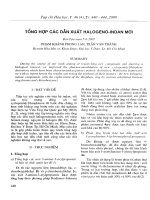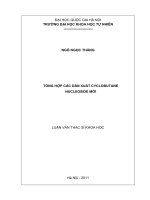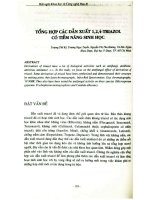DSpace at VNU: Tổng hợp các dẫn xuất nucleoside mới
Bạn đang xem bản rút gọn của tài liệu. Xem và tải ngay bản đầy đủ của tài liệu tại đây (123.72 KB, 10 trang )
Tổng hợp các dẫn xuất nucleoside mới
Ngô Ngọc Thắng
Trường Đại học Khoa kọc Tự nhiên
Luận văn ThS Chuyên ngành: Hóa hữu cơ; Mã số: 60 44 27
Người hướng dẫn: GS. TSKH. Đặng Như Tại
Năm bảo vệ: 2011
Abstract: Giới thiệu về các dẫn xuất nucleoside với hoạt tính chống virus;
định hướng nghiên cứu; phương pháp tổng hợp; định hướng tổng hợp. Kết
quả và thảo luận: tổng hợp hợp chất trung gian chìa khóa azide; tổng hợp
các dẫn xuất cyclobutane nucleoside; các đặc trưng cấu trúc của các
cyclobutane nucleoside. Đưa ra kết quả thực nghiệm.
Keywords: Hóa hữu cơ; Hóa học; Nucleoside
Content
Từ khi con người hiểu biết về các cơ chế sinh học chi phối quá trình trao đổi chất
của tế bào, lợi ích của việc tìm ra các hợp chất có khả năng ngăn chặn hoặc biến đổi quá
trình này không ngừng tăng lên. Rất nhiều dãy chất đã được nghiên cứu nhằm mục đích
tìm ra cách điều trị hiệu quả chống lại các bệnh khác nhau. Tuy nhiên, hiện nay, dù với
các tiến bộ vượt bậc của y học hiện đại, vẫn còn tồn tại một số bệnh ở người chưa có
phương pháp điều trị. Sự tăng lên không ngừng số lượng các ca ung thư cũng như các
bệnh mới do virut gây ra, ví dụ như virus gây suy giảm miễn dịch mắc phải ở người
(HIV), đã trở thành mối lo ngại lớn đối với cộng đồng.
Các phương pháp hóa trị liệu đang được sử dụng tồn tại hai nhược điểm chính: sự
kháng thuốc của các khối u ung thư và các virut, và độc tính của các hợp chất hóa học đối
với các tế bào khỏe mạnh. Vi thế, hiện nay, việc phát hiện các hợp chất mới có hoạt tính
sinh học luôn luôn cần thiết.
Trong số rất nhiều các hợp chất có hoạt tính sinh học, các dẫn xuất nucleoside là
nhóm chất đặc biệt quan trọng trong cuộc chiến chống lại sự nhiễm bệnh do virut gây ra,
như AIDS (HIV), viêm gan B (VHB) hay Herpes (HSV). Đồng thời nhóm chất này cũng
đóng một vai trò đáng kể trong các nghiên cứu về hóa trị liệu chống ung thư.
Trong số đó, oxetanocin1 (1) và các dẫn xuất carbocyclic của hợp chất này là
cyclobut-A và cyclobut-G2 (2) là những ví dụ tiêu biểu nhất thuộc dãy nucleoside vòng 4
có chứa hai nhóm hydroxyl có hoạt tính chống HIV, herpes hoặc cytomegalovirus.
Mặt khác, một số N- và C-nucleoside có chứa dị vòng trong phân tử là những tác
nhân kháng virut và khối u, tiêu biểu là Showdomycin3 (3), Tiazofurin4 (4),
Pyranomycin5 (5) và Ribavirin6 (6).
Trong báo cáo này chúng tôi trình bày về các kết quả nghiên cứu tổng hợp các
Ncyclobutane
trihydroxyl nucleoside dẫn xuất của ribavirin (A, B).
Kết quả:
Hợp chất trung gian chìa khóa azide 1 ((((1R,4S)-4-(azidomethyl)cyclobut2-enyl)methoxy)(tert-butyl)diphenylsilane) được tổng hợp từ chất đầu sau 9
giai đoạn với hiệu suất cao (37,82%) và chọn lọc lập thể, hợp chất này chưa
được công bố trong tài liệu tham khảo.
Từ hợp chất trung gian azide 1, tổng hợp được 5 hợp chất cyclobutene
trung gian mới, từ đó tổng hợp được 12 dẫn xuất cyclobutane nucleoside
mới được đưa ra ở bảng 2.2.
Cấu trúc của các chất mới được khẳng định bằng các phương pháp hóa lý
hiện đại.
Các dẫn xuất đang được gửi đi thử hoạt tính chống virus và chống ung thư.
Summary of thesis:
Nucleoside analogues are a class of biologically active compounds; several of
them show significant antiviral activity. Particularly, when the oxygen in the sugar
moiety is replaced by a methylene unit, the obtained nucleoside analogues are highly
resistant to phosphorylase enzyme, which cleaves the glycosidic linkage. Many
substances containing cyclopropane , cyclobutane , cyclopentane , and cyclohexane ring
were synthesized. Some of them have potent bioactivity, for example, aristeromycin A,
neplanocin A, abacavir, baraclude and lobucavir are used as antiviral drugs.
Baraclude Loducavir (Cyclobut-G)
Cyclobutyl nucleoside analogues have been of interest since oxetanocin A was
reported as a potential antiviral agent. This direction leads to the discovery of cyclobut-A
and cyclobut-G, which inhibit the replication of HIV in vitro.
When the base moiety of nucleoside is modified, many analogues have been
reported having potential bioactivities, and many of them are used as drugs: Bredinin - an
imidazole nucleoside used as an immunosuppressive agent, Ribavirin – an antiviral
drugs, and 1,2,3-triazole TSAO analogues – are used in the treatment of hepatitis C and
HIV (3, 50).
Brevidin Ribavirin 1,2,3-triazole TSAO
In this context, we propose to synthesize new cyclobutane analogues as follows:
Key mediate azide comound 1 ((((1R,4S)-4-(azidomethyl)cyclobut-2enyl)methoxy)(tert-butyl)diphenylsilane) is synthesized via 9 stage with
high yeild (37,82%), this compound has not reported in any literature.
From azide 1, we have synthesized 5 new cyclobutene nucleoside, then 12
new cyclobutane nucleosidestổng
Structures of new compounds are confirmed by modern methods such as
NMR, MS.
New cyclobutane nucleoside are sending to bioassay tests.
References
1. Alexandre C., Pichon C. (2000), "Enzymatic acylation of cyclobutene and
cyclobutane meso-diols at low temperature", Science 11, pp. 2429-2434.
2. Alibe R, March PD, Figueredo M, Font J, and Racamonde M. (2003),
"Photocycloaddition of ( Z ) -1 , 2-dichloroethylene to enantiopure 2 ( 5H ) furanones: an efficient strategy for the diastereoselective synthesis of
cyclobutane and cyclobutene derivatives", Synthesis 44, pp. 69-71.
3. Alvarez R, Velázquez S, San-Félix A, Aquaro S, De Clercq E, Perno CF,
Karlsson A, Balzarini J, and Camarasa MJ. (1994), "1,2,3-Triazole-[2’,5'-bis-
O-(tert-butyldimethylsilyl)-beta-D- ribofuranosyl]-3'-spiro-5“-(4”-amino1“,2”-oxathiole 2“,2”-dioxide) (TSAO) analogues: synthesis and anti-HIV-1
activity", Journal of medicinal chemistry 37(24), pp. 4185-94.
4. Arts EJ and Wainberg MA. (1996), "Mechanisms of nucleoside analog antiviral
activity and resistance during human immunodeficiency virus reverse
transcription", Antimicrobial agents and chemotherapy 40(3), pp. 527-40.
5. Bach T, Bergmann H, and Harms K. (2001), "Enantioselective Photochemical
Reactions of 2-Pyridones in Solution", Organic Letters 3(4), pp. 601-603.
6. Baschang G and Inderbitzin W. (1992), "The enantiomers of 1β-adenyl-2αhydroxy-3β-hydroxymethyl-cyclobutane", Tetrahedron: Asymmetry 3(2), pp.
193-196.
7. Besada P, Terán C, Santana L, Teijeira M, and Uriarte E. (1999), "Nucleoside
Analogues of Purine with a 1,2-Disubstituted Cyclopentene Ring",
Nucleosides and Nucleotides 18(4-5), pp. 725-726.
8. Borchardt RT, Keller BT, and Patel-Thombre U. (1984), "Neplanocin A. A
potent inhibitor of S-adenosylhomocysteine hydrolase and of vaccinia virus
multiplication in mouse L929 cells", The Journal of biological chemistry
259(7), pp. 4353-8.
55
9. Boren BC, Narayan S, Rasmussen LK, Zhang L, Zhao H, Lin Z, Jia G, and Fokin
VV. (2008), "Ruthenium-catalyzed azide-alkyne cycloaddition: scope and
mechanism", Journal of the American Chemical Society 130(28), pp. 892330.
10.Chittepu P, Sirivolu VR, and Seela F. (2008), "Nucleosides and oligonucleotides
containing 1,2,3-triazole residues with nucleobase tethers: synthesis via the
azide-alkyne “Click” reaction", Bioorganic & medicinal chemistry
16(18):8427-39.
11. Chênevert R, Pelchat N, and Morin P. (2009), "Lipase-mediated
enantioselective acylation of alcohols with functionalized vinyl esters: acyl
donor tolerance and applications", Tetrahedron: Asymmetry 20(10), pp. 11911196.
12. De Clercq E. (2004), "Antiviral drugs in current clinical use", Journal of clinical
virology: the official publication of the Pan American Society for Clinical
Virology 30(2), pp. 115-33.
13. De Clercq E. (2007), "The design of drugs for HIV and HCV",Nature reviews.
Drug discovery 6(12), pp. 1001-18.
14. Crimmins M. (1998), "New developments in the enantioselective synthesis of
cyclopentyl carbocyclic nucleosides", Tetrahedron 54(32), pp. 9229-9272.
15. Cucarull-González JR, Hernando J, Alibés R, Figueredo M, Font J, RodríguezSantiago L, and Sodupe M. (2010), "[2 + 2] Photocycloaddition of 2(5H)furanone to unsaturated compounds. insights from first principles calculations
and transient-absorption measurements", The Journal of organic chemistry
75(13), pp. 4392-401.
16. Du J and Yoon TP. (2009), "Crossed intermolecular [2+2] cycloadditions of
acyclic enones via visible light photocatalysis", Journal of the American
Chemical Society 131(41), pp. 14604-5.
17. Furman PA, Fyfe JA, St Clair MH, Weinhold K, Rideout JL, Freeman GA,
Lehrman SN, Bolognesi DP, Broder S, and Mitsuya H. (1986),
56
"Phosphorylation of 3’-azido-3'-deoxythymidine and selective interaction of
the 5'-triphosphate with human immunodeficiency virus reverse
transcriptase", Proceedings of the National Academy of Sciences of the United
States of America 83(21), pp. 8333-7.
18. Gauvry N, Comoy C, Lescop C, and Huet F. (1999), "A New Synthesis of cisCyclobut-3-ene-1,2-dicarboxylic Anhydride", Synthesis 1999(04), pp. 574576.
19. Grimes KD, Gupte A, and Aldrich CC. (2010), "Copper(II)-Catalyzed
Conversion of Aryl/Heteroaryl Boronic Acids, Boronates, and
Trifluoroborates into the Corresponding Azides: Substrate Scope and
Limitations", Synthesis, pp. 1441-1448.
20. Guan HP, Ksebati MB, Kern ER, and Zemlicka J. (2000), "Approaches to
unsaturated analogues of nucleosides comprising four- and six-membered
rings", The Journal of organic chemistry 65(17), pp. 5177-84.
21. Halvas EK, Svarovskaia ES, Freed EO, and Pathak VK. (2000), "Wild-Type and
YMDD Mutant Murine Leukemia Virus Reverse Transcriptases Are Resistant
to 2’,3'-Dideoxy-3'-Thiacytidine", Journal of Virology 74(14), pp. 6669-6674.
22. Hansen SG and Jensen HH. (2009), "Microwave Irradiation as an Effective
Means of Synthesizing Unsubstituted N-Linked 1,2,3-Triazoles from Vinyl
Acetate and Azides", Synlett, pp. 3275-3278.
23. Hara P, Mikkola J-P, Murzin DY, and Kanerva LT. (2010), "Supported ionic
liquids in Burkholderia cepacia lipase-catalyzed asymmetric acylation",
Journal of Molecular Catalysis B: Enzymatic 67(1-2), pp. 129-134.
24. Hayashi S, Norbeck DW, Rosenbrook W, Fine RL, Matsukura M, Plattner JJ,
Broder S, and Mitsuya H. (1990), "Cyclobut-A and cyclobut-G, carbocyclic
oxetanocin analogs that inhibit the replication of human immunodeficiency
virus in T cells and monocytes and macrophages in vitro", Antimicrobial
agents and chemotherapy 34(2), pp. 287-94.
57
25. Hewlett G, Hallenberger S, and Rübsamen-Waigmann H. (2004), "Antivirals
against DNA viruses (hepatitis B and the herpes viruses)", Current opinion in
pharmacology 4(5), pp. 453-64.
26. Hilt G, Paul A, and Treutwein J. (2010), "Cobalt catalysis at the crossroads:
cobalt-catalyzed Alder-ene reaction versus [2 + 2] cycloaddition", Organic
letters 12(7), pp. 1536-9.
27. Himo F, Lovell T, Hilgraf R, Rostovtsev VV, Noodleman L, Sharpless KB, and
Fokin VV. (2005), "Copper(I)-catalyzed synthesis of azoles. DFT study
predicts unprecedented reactivity and intermediates", Journal of the American
Chemical Society 127(1), pp. 210-6.
28. Hu Z and Kuritzkes DR. (2011), "Interaction of reverse transcriptase (RT)
mutations conferring resistance to lamivudine and etravirine: effects on
fitness and RT activity of human immunodeficiency virus type 1",Journal of
virology 85(21), pp. 11309-14.
29. Hughes W, McDowell JA, Shenep J, Flynn P, Kline MW, Yogev R, Symonds
W, Lou Y, and Hetherington S. (1999), "Safety and single-dose
pharmacokinetics of abacavir (1592U89) in human immunodeficiency virus
type 1-infected children", Antimicrobial agents and chemotherapy 43(3), pp.
609-15.
30. Huisgen R. (1961), Proceedings of the Chemical Society(October), pp. 357.
31. Humble RW, Middleton DF, Banoub J, Ewing DF, Boa AN, and Mackenzie G.
(2011),"A synthesis of bredinin (Mizoribine®) from an acyclic precursor",
Tetrahedron Letters 52(47), pp. 6223-6227.
32. Ichikawa E and Kato K. (2001), "Sugar-modified nucleosides in past 10 years, a
review", Current medicinal chemistry 8(4), pp. 385-423.
33. Ischay MA, Anzovino ME, Du J, and Yoon TP. (2008), "Efficient visible light
photocatalysis of [2+2] enone cycloadditions", Journal of the American
Chemical Society 130(39), pp. 12886-7.
58
34. Ishikawa H. (1980), "A new clinically useful immunosuppressive drug,
bredinin", International Journal of Immunopharmacology 2(3), pp. 219.
35. Ito H, Toyoda T, and Sawamura M. (2010), "Stereospecific synthesis of
cyclobutylboronates through copper(I)-catalyzed reaction of homoallylic
sulfonates and a diboron derivative", Journal of the American Chemical
Society 132(17), pp. 5990-2.
36. Jiang Y, Kuang C, and Yang Q. (2009), "The Use of Calcium Carbide in the
Synthesis of 1-Monosubstituted Aryl 1,2,3-Triazole via Click Chemistry",
Synlett, pp. 3163-3166.
37. Kaiwar V, Reese CB, Gray EJ, and Neidle S. (1995), "Synthesis of 9-[cis-3(hydroxymethyl)cyclobutyl]-adenine and -guanine", Journal of the Chemical
Society, Perkin Transactions 1(18), pp. 2281.
38. López-Carrillo V and Echavarren AM. (2010), "Gold(I)-catalyzed
intermolecular [2+2] cycloaddition of alkynes with alkenes", Journal of the
American Chemical Society 132(27), pp. 9292-4.
39. Meijere D. (1997), Houben-Weyl Methods of Organic Chemistry: Carbocyclic
Four-Membered Ring Compounds. Thieme: Stuttgart.
40. Qui YL, Ksebati MB, and Zemlicka J. (2000), "Synthesis of (Z)- and (E)-9-[(2hydroxyethylidene)cyclopropyl]adenine--new methylenecyclopropane
analogues of adenosine and their substrate activity for adenosine deaminase",
Nucleosides, nucleotides & nucleic acids 19(1-2), pp. 31-7.
41. Rasmussen LK, Boren BC, and Fokin VV. (2007), "Ruthenium-Catalyzed
Cycloaddition of Aryl Azides and Alkynes", Org. Lett. 9, pp. 5337-5339.
42. Reddy KR, Nelson DR, and Zeuzem S. (2009), "Ribavirin: current role in the
optimal clinical management of chronic hepatitis C", Journal of hepatology
50(2), pp. 402-11.
43. Robinson DM, Scott LJ, and Plosker GL. (2006), "Entecavir: a review of its use
in chronic hepatitis B", Drugs 66(12), pp. 1605-22.
59
44. Rostovtsev VV, Green LG, Fokin VV, and Sharpless KB. (2002), "A stepwise
huisgen cycloaddition process: copper(I)-catalyzed regioselective “ligation”
of azides and terminal alkynes", Angewandte Chemie (International ed. in
English) 41(14), pp. 2596-9.
45. Rustullet A, Alibés R, de March P, Figueredo M, and Font J. (2007),
"Stereoselective route to oxetanocin carbocyclic analogues based on a [2 + 2]
photocycloaddition to a chiral 2(5H)-furanone", Organic letters 9(15), pp.
2827-30.
46. Shealy YF and Clayton JD. (1966), "9-[β-DL-2α,3α-Dihydroxy-4β-
(hydroxymethyl)- cyclopentyl]adenine, the Carbocyclic Analog of
Adenosine1,2", J. Am. Chem. Soc. 88(16), pp. 3885-3887.
47. Shimada N, Hasegawa S, Harada T, Tomisawa T, Fujii A, and Takita T. (1986),
"Oxetanocin, a novel nucleoside from bacteria", The Journal of antibiotics
39(11), pp. 1623-5.
48. Stellbrink H-J. (2007), "Antiviral drugs in the treatment of AIDS: what is in the
pipeline", European journal of medical research 12(9), pp. 483-95.
49. Tisdale M. (1993), "Rapid in vitro Selection of Human Immunodeficiency Virus
Type 1 Resistant to 3’-Thiacytidine Inhibitors Due to a Mutation in the
YMDD Region of Reverse Transcriptase", Proceedings of the National
Academy of Sciences 90(12), pp. 5653-5656.
50. Velázquez S, Alvarez R, Pérez C, Gago F, De Clercq E, Balzarini J, Camarasa
M-j J, and Clercq ED. (1998), "Regiospecific synthesis and anti-human
immunodeficiency virus activity of novel 5-substituted N-alkylcarbamoyl and
N,N-dialkylcarbamoyl 1,2,3-triazole-TSAO analogues", Antiviral chemistry
& chemotherapy 9(6), pp. 481-9.
51. Vite GD, Tino JA, Zahler R, Goodfellow V, Tuomari AV, McGeever-Rubin B,
and Field AK. (1993), "Differences in antiviral activities for isomers of a
fluorinated cyclobutane nucleoside analog", Bioorganic& Medicinal
Chemistry Letters 3(6), pp. 1211-1214.
60
52. Wang B-L, Shi Y-X, Ma Y, Liu X-H, Li Y-H, Song H-B, Li B-J, and Li Z-M.
(2010), "Synthesis and biological activity of some novel trifluoromethylsubstituted
1,2,4-triazole and bis(1,2,4-triazole) Mannich bases containing
piperazine rings", Journal of agricultural and food chemistry 58(9), pp. 551522.
53. Wang J, Busson R, Blaton N, Rozenski J, and Herdewijn P. (1998),
"Enantioselective Approach to the Synthesis of Cyclohexane Carbocyclic
Nucleosides", The Journal of Organic Chemistry 63(9), pp. 3051-3058.
54. Weiss RA. (2001),"Gulliver’s travels in HIVland", Nature 410(6831), pp. 9637.
55. Xu M, Kuang C, Wang Z, Yang Q, and Jiang Y. (2011), "A Novel Approach to
1-Monosubstituted 1,2,3-Triazoles by a Click Cycloaddition/Decarboxylation
Process",Synthesis, pp. 223-228.
56. Zhu XF. (2000), "The latest progress in the synthesis of carbocyclic
nucleosides", Nucleosides, nucleotides & nucleic acids 19(3), pp. 651-90.
57. Özçubukçu S, Ozkal E, Jimeno C, and Pericàs MA. (2009), "A Highly Active
Catalyst for Huisgen 1,3-Dipolar Cycloadditions Based on the
Tris(triazolyl)methanol-Cu(I) Structure", Org. Lett. 11, pp. 4680-4683.
58. 2007 AIDS epidemic update.
59. " Tình hình nhiễm HIV/AIDS đến hết ngày 31/3/2009",
http://203.162.71.9/ubcvdxh/default.aspx?tabid=362&ID=845.









